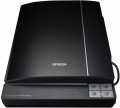Max. resolution
The highest resolution of the digital image generated by the scanner during operation. Specified in dots per inch — dpi (dots per inch).
The higher the scan resolution, the higher the resolution of the resulting image will be (with the same size of the source material) and the more accurately small details will be transmitted on it. On the other hand, high resolution noticeably affects the price of the scanner, increases the processing time and the size of the resulting file — despite the fact that the real need for high detail is not always present, and in some cases it is even unnecessary (for example, when processing an image with small artifacts, not visible at low detail). Therefore, when choosing by this parameter, you should not chase high resolution values — you should proceed from the real need and the specifics of the intended use of the scanner.
The simplest modern scanners have a resolution of about 300x300 dpi — this is quite enough for text recognition with an average font size. And in high-end professional models, this figure can exceed 7000x7000 dpi.
Optical element
— CIS, abbreviation for "Contact Image Sensor" — contact image sensor. The simplest type of optical element: it is a line across the entire width of the scanner's working space, on which photocells that read the image and LEDs that provide illumination are located in a row. They are inexpensive and take up little space, which, accordingly, makes the scanners themselves cheaper and smaller. On the other hand,
CIS sensors have a shallow depth of field, and even small bumps in the scanned image can be out of focus. However, in general, they are quite suitable for both personal and not too complex professional tasks.
— CCD, short for "Charge-Coupled Device" — a charge-coupled device. A much more complex design than CIS, includes a fluorescent lamp, lens and mirror.
CCD scanners are larger, heavier and much more expensive than their counterparts in CIS. On the other hand, this type of optical element provides high-quality colour reproduction and a good depth of field, coping well with complex-shaped media. Therefore, advanced professional scanners are usually equipped with a CCD.
— CMOS. The abbreviation for "Complementary Metal-Oxide-Semiconductor" is a complementary metal-oxide-semiconductor structure (the designation CMOS is also used in Russian). A key feature
of CMOS sensors is that they capture the scanned image as a whole, similar to photography (and not
...line by line, as in other types of optical elements). In fairness, it should be noted that the "instantaneous" scanning does not give a tangible advantage in speed, because. processing the captured image takes quite a long time. However, this feature is extremely useful in cases where it is difficult to ensure the immobility of the scanned material and/or uniform movement of the optical element relative to this material. Such situations often arise when working with book and handheld scanners (see "Type"), so CMOS elements are most popular in such devices.Max. scan area
The maximum image size that the scanner can process at one time, both horizontally and vertically. You should pay attention to this parameter if you need the exact dimensions of the scanner's working area, down to a millimetre: although standard formats are used to designate these dimensions (see "Format"), in fact the dimensions may differ from them.
Optical density
The maximum optical density of a dark image that the scanner can distinguish from pure black. Optical density characterizes how much of the light falling on the image was reflected (for opaque images) or transmitted (for transparent). The higher the optical density, the less light the object reflects / transmits. Accordingly, the higher the optical density of the scanner, the higher its sensitivity and the better it is suitable for working with dark images.
Slide module
By default, the scanner is designed to work with reflective, i.e. opaque materials (such as paper).
The slide module allows you to use the device for processing transparent materials, such as photographic film.
Power source
— From the network. The most common option is to connect to a conventional 230 V power supply. This power supply provides enough power to operate any, even the fastest and most performant scanners. Its disadvantage is, in fact, the need for an electrical network.
— From USB.
Powered via USB port — the same through which it connects to the computer. This significantly increases the battery life of the scanner — in particular, it can be used with a laptop in places where there is no access to a 230 V network, which is especially important for portable models (see "Portable Design"). On the other hand, the performance of such devices is usually low, and the power of the USB port is not always enough for power supply (which is especially true when using USB hubs).
— Autonomous. Power supply of the scanner from its own batteries (accumulator or replaceable batteries). Such models are as autonomous as possible, because do not require a power cord to operate, and many of them are able to act as separate devices without being connected to a PC at all. Their disadvantage is the risk of switching off at the most inopportune moment due to the exhaustion of the charge — then you have to either change the batteries (which at least requires fresh ones) or recharge the battery (which takes time).
Power consumption
The maximum power consumed by the scanner during operation. The higher the power, the more energy the scanner consumes, but this only applies to the scanning process itself — in standby mode, power consumption is negligible. And even at the peak in most models, the power is so low that in fact this parameter has practically no effect on electricity bills and is more of an auxiliary value (for example, it is used to calculate the total power of devices connected to an uninterruptible power supply).

